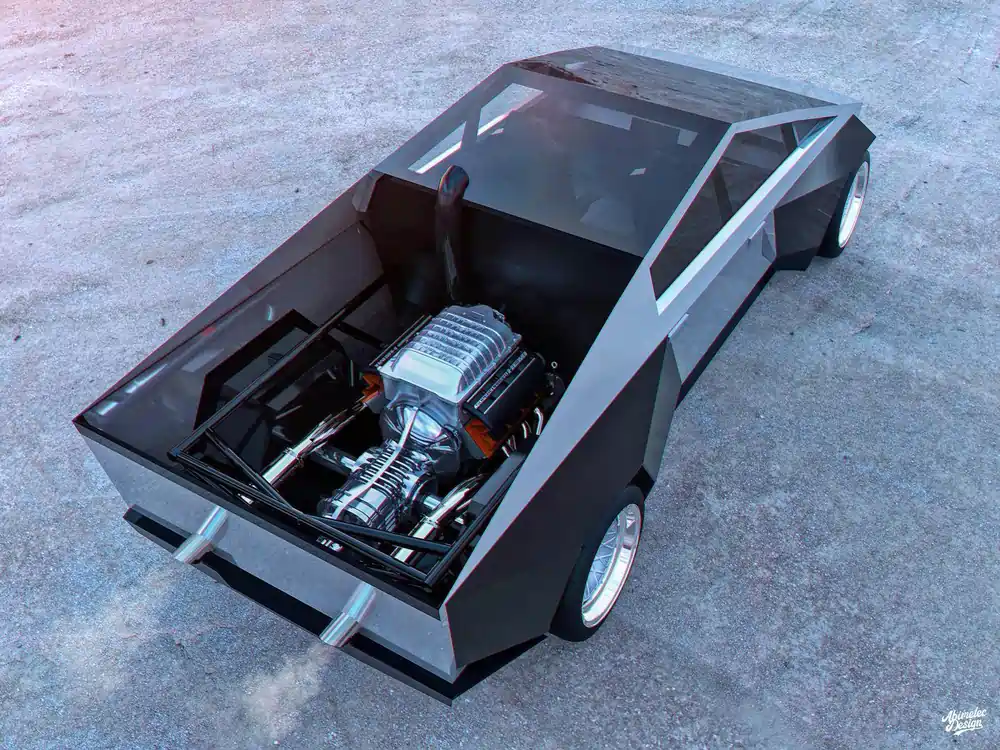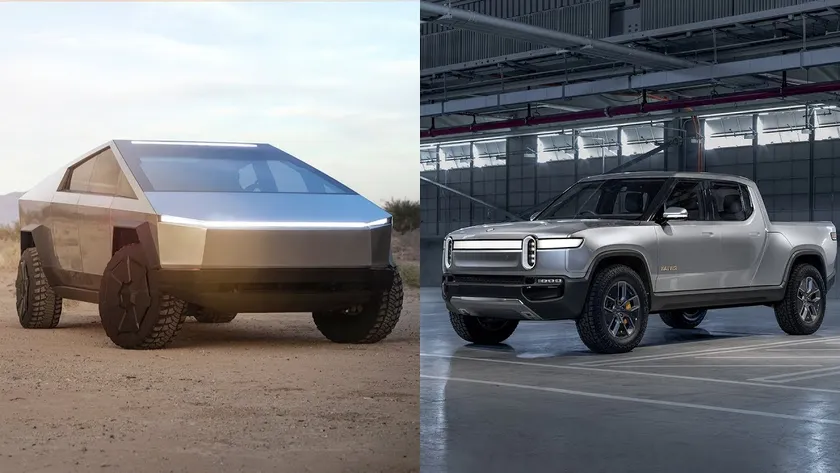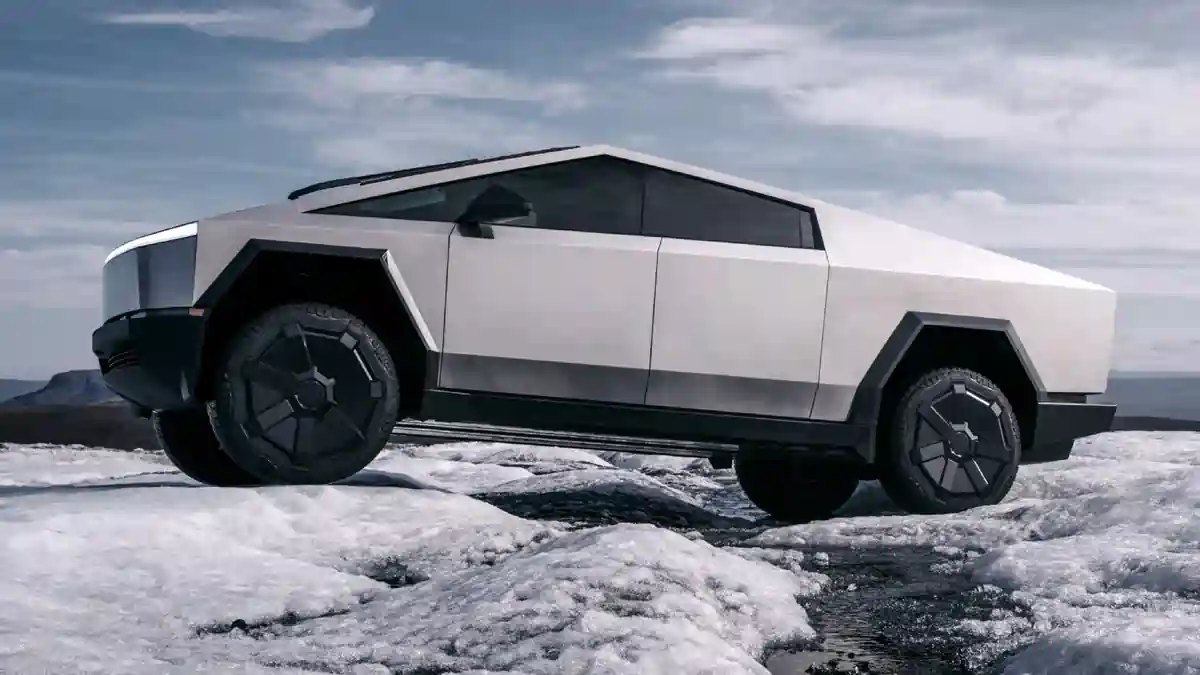The story of the Tesla Cybertruck is quite captivating, reflecting Tesla’s forward-looking vision as well as CEO Elon Musk’s ambitions in the electric vehicle space.
From its inception, the Tesla Cybertruck aimed to redefine the pickup truck category with a design and features that radically break from convention. Its futuristic, angular design, reminiscent of science fiction vehicles, stems from a design philosophy that prioritizes functionality with the premise of starting “from a blank sheet of paper,” according to Musk. This approach led to a vehicle with a body made of cold-rolled stainless steel, chosen for its durability and resistance to corrosion but also posing challenges in terms of manufacturing and repair.
The initial unveiling of the Cybertruck took place in November 2019, during an event that captured global attention not just for the vehicle itself but for an incident during a demonstration of its window strength, which unexpectedly broke. Despite this setback, the event underscored Tesla’s willingness to innovate and challenge established norms in the automotive industry.
The Cybertruck is designed to combine the utility of a pickup truck with the performance characteristic of Tesla’s electric vehicles, offering impressive towing and payload capabilities along with acceleration that rivals sports cars. It was announced to come in several versions, with different motor and drivetrain configurations, to cater to a broad range of needs and budgets.
Since its unveiling, the journey to production for the Cybertruck has faced several hurdles, including delays attributed to engineering challenges and the COVID-19 pandemic, adjusting the initially anticipated delivery schedule. Nonetheless, Tesla has remained committed to the Cybertruck, viewing it as a key component in its future market expansion of electric vehicles.
Tesla Cybertruck Specifications:
Dimensions:
- Length: 5,881 mm
- Width: 2,027 mm
- Height: 1,905 mm
- Wheelbase: 3,581 mm
- Ground clearance: 406 mm
Weight:
- Curb weight: 2,995 kg (AWD) / 3,104 kg (Tri-motor)
- Maximum towing capacity: 6,350 kg
Performance:
- 0-60 mph acceleration:
- 2.9 seconds (Tri-motor)
- 4.5 seconds (AWD)
- 6.5 seconds (RWD)
- Top speed:
- 130 mph (Tri-motor)
- 120 mph (AWD)
- 110 mph (RWD)
Range:
- Over 500 miles (Tri-motor)
- Over 300 miles (AWD)
- Over 250 miles (RWD)
Payload capacity:
- Cargo bed volume: 120.9 cu ft
- Payload capacity: 3,500 lbs
Other features:
- Adaptive air suspension
- Standard all-wheel drive (AWD)
- Tesla Autopilot
- 17-inch center touchscreen
- 12-inch digital instrument cluster
- “Tesla Armor Glass” bulletproof windows
- Up to 24 inches of wading depth
How the Tesla Cybertruck Works Internally:

1. Chassis and Body:
- The Cybertruck is built on a steel platform with a stainless steel exoskeleton.
- This structure gives it great strength and rigidity, ideal for heavy-duty work.
- The body is made of 3mm thick stainless steel panels that are bullet and dent proof.
- The Cybertruck’s angular and minimalist design reduces aerodynamic drag and improves efficiency.
2. Powertrain:
- The Cybertruck will be available with three powertrain options:
- Rear-wheel drive (RWD): One electric motor on the rear axle.
- All-wheel drive (AWD): Two electric motors, one on each axle.
- Tri-motor: Three electric motors, one on each axle and an additional one on the front axle.
- Electric motors offer instant performance and great acceleration.
- The battery is located under the chassis to lower the center of gravity and improve stability.
3. Suspension:
- The Cybertruck has adaptive air suspension that automatically adjusts to road conditions.
- This allows for a smooth and comfortable ride both on-road and off-road.
- The suspension can also be raised to increase ground clearance in difficult terrain.
4. Brakes:
- The Cybertruck has regenerative disc brakes on all four wheels.
- These brakes recover energy during braking and store it in the battery.
- This increases the vehicle’s range.
5. Technology:
- The Cybertruck will be equipped with Tesla’s latest technology, including:
- Autopilot: Autonomous driving system
- FSD (Full Self-Driving): Full autonomous driving capability
- 17-inch center touchscreen
- Over-the-air software updates
6. Cargo Capacity:
- The Cybertruck has a large cargo capacity, with a volume of up to 120.9 cu ft.
- The Cybertruck’s tailgate opens down and becomes a ramp for easy loading and unloading.
- The Cybertruck also has a front storage compartment with a capacity of 7.1 cu ft.
7. Autopilot Technology:
- The Cybertruck is expected to include Tesla’s Autopilot driver assistance system, which uses a combination of cameras, ultrasonic sensors, and radar, along with advanced software, to offer autonomous driving capabilities and driver assistance features.
8. High-Capacity Battery:
- Like other Tesla vehicles, the Cybertruck is powered by a high-capacity lithium-ion battery pack, integrated into the vehicle’s floor. This provides a low center of gravity, enhancing stability and handling. The batteries are designed to offer a significant range per charge, with Tesla promising various range options from 250 to over 500 miles on a single charge, depending on the model.
Overall, the Tesla Cybertruck is an innovative and technologically advanced electric vehicle that offers high performance, long range, and spacious cargo capacity.
Controversies surrounding the Tesla Cybertruck
The Tesla Cybertruck has been embroiled in various controversies since its unveiling, fueling debates within the automotive industry and among the general public. Here are some of the main controversies associated with the Cybertruck:
Futuristic and Divisive Design:
The futuristic design of the Tesla Cybertruck has garnered mixed reactions from experts and the public alike. Renowned automotive designer Giorgetto Giugiaro praised Elon Musk’s vehicle, referring to it as “the Picasso of vehicles” due to its daring and revolutionary design, which breaks away from traditional conceptions of what a ‘pick-up’ should look like. Giugiaro admires Musk’s courage to depart from conventional forms and predicts that the Cybertruck will be a great success because people want to stand out, valuing its emotion and robustness over harmony and perfection.
From a technical standpoint, the unique design of the Cybertruck is not only aesthetically innovative but also offers practical benefits. For example, it has been highlighted that the design significantly contributes to the vehicle’s aerodynamics, achieving an aerodynamic coefficient of 0.39. This coefficient is remarkably low for a pick-up, implying less wind resistance and, consequently, better autonomy. This aerodynamic achievement is largely due to its regular geometric shapes and sharp lines, which avoid wind swirls, and features like the rear diffuser that reduce wind resistance.
Elon Musk’s launch of the Cybertruck has been a standout event, aiming to impress and clearly differentiate this vehicle from conventional market options. With features like the Tesla Armor Glass for increased impact resistance and the ultra-resistant stainless steel Exoskeleton, the Cybertruck promises not just an innovative design but also advanced levels of safety and durability. Furthermore, its futuristic interior and the capability for full autonomous driving add to the vehicle’s appeal, offered in different versions to meet various needs for autonomy and performance.
Bulletproof” Windows Demonstration:
The failed demonstration of the Tesla Cybertruck’s windows is one of the most memorable and discussed moments from the vehicle’s unveiling event in November 2019. During the presentation, Elon Musk aimed to showcase the strength and durability of the Cybertruck’s armored glass, a key component of the vehicle’s promise of safety and ruggedness.
To do this, a live demonstration was conducted in front of the audience and viewers watching the event online. Franz von Holzhausen, Tesla’s Chief Designer, was tasked with performing the test. He first threw a metal ball at the driver’s side window of the Cybertruck. Contrary to expectations, the glass broke, although it did not shatter completely, suggesting that the glass was indeed more resistant than standard glass but not invulnerable.
Surprised by the outcome, Musk asked to repeat the test on the rear window, thinking the first incident might have been a fluke. However, the result was the same: the glass broke again to the astonishment of the audience and a visibly perplexed Musk.
This moment immediately went viral, generating a flood of memes, jokes, and discussions on social media and in the news. Despite this setback, Musk explained that the glass had undergone pre-tests that weakened its integrity, which could have contributed to its failure to withstand the impact during the demonstration.
While the failed glass demonstration was embarrassing for Tesla at the time, it also served to increase the notoriety of the Cybertruck, making it one of the most talked-about and debated topics in the technology and electric vehicle world. Musk and his team’s reaction to this unforeseen event highlighted their willingness to face challenges and mistakes publicly, reaffirming their commitment to innovation and continuous improvement of their products.
Production Delays:
The production of the Tesla Cybertruck has seen several delays since its initial announcement. Originally unveiled in 2019 with an expectation to hit the market by the end of 2021, the timeline for the start of production has been pushed back multiple times. Most recently, it has been reported that Tesla aims to start mass production of the Cybertruck at the end of 2023, which marks a delay of two years from the initial target. Early production was slated to begin in the middle of 2023, with a gradual ramp-up to full output expected in the second half of the year, meaning significant revenue from the Cybertruck would not be recorded until early 2024. This delay affects the estimated hundreds of thousands of potential buyers who have paid a reservation fee for the Cybertruck, one of the most highly anticipated electric vehicle launches.
Despite the delays, there has been some confusion and misreporting regarding the Cybertruck’s production timeline. Some reports suggested further delays, but closer examination reveals that Tesla is still on track with its revised schedule, aiming for mass production by the end of 2023. This timeline would actually indicate an aggressive ramp-up to mass production if it begins as planned in mid-2023. However, it’s essential to note that achieving mass production within such a short timeframe after the start of production would be unprecedented for Tesla, indicating a very ambitious goal.
The Cybertruck’s production has faced challenges, including the need to finalize the development of Tesla’s 4680 batteries, which are crucial for the vehicle. Elon Musk has mentioned that the 4680 batteries are not expected to be a limiting factor for the Cybertruck or any other Tesla product, highlighting efforts to increase battery output.
Regulation and Safety:
The Cybertruck’s unique shape and features have raised questions about its compliance with vehicle safety regulations, especially in markets outside the United States. Concerns focus on whether its design meets safety standards for pedestrians and other vehicles in the event of a collision, due to its unusually rigid exterior structure and sharp angles.
Direct competition from the Tesla Cybertruck

The Tesla Cybertruck, with its distinct angular design and robust specifications, positions itself as a unique contender in the electric pickup truck market, directly competing with the Rivian R1T and Ford F-150 Lightning. These vehicles signify a significant shift towards electrification in the pickup truck segment, each with their own set of features and capabilities.
Size and Design:
- The Cybertruck’s design is groundbreaking, featuring a sharp, angular look that sets it apart from traditional pickup trucks. In comparison, the Rivian R1T and Ford F-150 Lightning maintain a more conventional appearance, though they’re both electric.
- In terms of size, the F-150 Lightning is the longest, followed by the Cybertruck and then the Rivian R1T. The Cybertruck and R1T both offer innovative storage solutions, with the Cybertruck being notable for its larger size, which contributes to its utility aspect.
Performance and Utility:
- The Cybertruck and R1T are aimed at offering high performance and utility, with the Cybertruck boasting a towing capacity of up to 14,000 pounds compared to the R1T’s 11,000 pounds. The Cybertruck also claims a higher payload capacity.
- In terms of performance, Tesla’s Cybertruck (Cyberbeast) and Rivian’s R1T (Performance) both promise impressive acceleration, with the Cybertruck slightly edging out in terms of horsepower, torque, and acceleration from 0-60 mph. The Ford F-150 Lightning, while still powerful, offers more modest figures in these areas.
Range and Charging:
- The Rivian R1T offers a range of up to 400 miles with its largest battery pack, while the Cybertruck promises between 250 and 500 miles depending on the battery option chosen. The Ford F-150 Lightning claims a range of up to 328 miles with its extended-range battery.
- Charging capabilities are also a crucial factor, with the Cybertruck supporting Tesla’s Supercharger network, potentially offering faster charge times compared to the Rivian R1T and Ford F-150 Lightning, which also have substantial charging capabilities but with different peak rates.
Driving Experience:
- The driving experience varies significantly across these models. The Rivian R1T is praised for its comfort and performance as a daily driver, with a focus on driver engagement and off-road capability. The Cybertruck offers a unique driving experience with its vast windshield and future-ready features, although its off-roading capabilities await further enhancements through software updates. The Ford F-150 Lightning is highlighted for its familiar truck feel, workspace convenience, and advanced driver assistance features.
In summary, the Tesla Cybertruck, Rivian R1T, and Ford F-150 Lightning each bring unique strengths to the table, from groundbreaking designs and utility to performance and electric range. The choice between them would depend on individual preferences for design, performance, utility, and technological features.
Testing of the Tesla Cybertruck in 2024:
In 2024, the Tesla Cybertruck underwent several road tests that provided insights into its performance and real-world capabilities. One of the first independent range tests revealed that the Cybertruck could cover 254 miles on the highway on a single charge, which is significantly less than the 320 miles EPA estimated range. This test was conducted at highway speeds and in cold conditions, highlighting how factors like temperature and driving speed can impact electric vehicle range.
In another real-world test, a Cybertruck driver documented a 1,340-mile road trip from Austin, Texas, to Joshua Tree National Park in California. Despite enjoying the ride and the comfort of the Cybertruck, the driver encountered issues such as reduced efficiency in range, necessitating frequent stops for charging—about every one to two hours. The driver attributed the inefficiencies to cooler temperatures and a tendency to speed. Additionally, charging the Cybertruck proved to be somewhat challenging at certain Supercharger stations due to the vehicle’s larger size, and there was a glitch in the infotainment system during the trip. However, the overall experience was positive, with the driver praising the Cybertruck’s interior and build quality.
These tests highlight the Cybertruck’s strengths, such as its comfort and innovative design, while also pointing out challenges related to its range and charging infrastructure compatibility. As with all electric vehicles, factors like driving conditions, temperature, and driving behavior can significantly affect range, underscoring the importance of real-world testing to understand the capabilities and limitations of new EV models.
Conclusion on the Tesla Cybertruck:
The Tesla Cybertruck marks a significant leap in the electric vehicle market with its futuristic design and robust capabilities. It offers various drivetrain configurations and a range of autonomy to suit different needs, targeting a broad audience from those interested in energy efficiency to those requiring performance and towing capacity. Despite an increase in price since its initial announcement, it remains a competitive proposition in the growing electric pickup segment, promising innovation in both functionality and design.
Positive Aspects:
- Futuristic and unique design
- High performance and acceleration
- Long range (over 500 miles on the Tri-Motor model)
- Spacious cargo capacity (up to 120.9 cu ft)
- Autonomous driving technology
- Over-the-air software updates
- Bullet and dent proof
Negative Aspects:
- High price (starting at $39,900 USD)
- Delayed delivery dates (late 2024 at the earliest)
- Controversial design
- Potential safety concerns for pedestrians
- Tesla’s charging network is not yet developed worldwide
Prices, Delivery Dates and Travel Capacity of the Tesla Cybertruck:
The Tesla Cybertruck’s pricing has evolved since its announcement in 2019, adapting to available configurations and market conditions. Rear-wheel drive models will be available from $60,990 with 250 miles of range, expected in 2025. The all-wheel drive version starts at $79,990 with a 340-mile range, and the high-end Cyberbeast model begins at $99,990 with a standard range of 320 miles, extending up to 440 miles with an extended range setup. Prices and specs may vary based on selected configurations and options.
Related posts
Subscribe for newsletter
* You will receive the latest news and updates on your favorite celebrities!

